Wednesday 14th April. 11 am. I enter Michelangelo‘s studio. I am meeting him in view of the article I want to write for Earth Day, celebrated every year by the United Nations a month and a day after the spring equinox, to draw attention to environmental sustainability and the safeguarding of our planet. Before proceeding with the interview, we informally discuss the issues associated with this event. His reactions, when we address these topics, amaze me: going into the conversation, he reveals a noticeable involvement. His reflections, animated with fervour, are accompanied by a magnetic energy. Even non-verbal communication leaves no doubts: we are dealing with issues that concern him deeply. You would think that it could not be otherwise, he has after all dedicated his life and his art to responsible change in society, and it is therefore easy to understand how the topics associated with the Earth Day are congenial to him. But it is one thing to deduce it from reading his books or learning about his life, another is to perceive it while talking face to face, looking into each other’s eyes.
This is how, on a windy April morning, I understood, even better than before, how much Michelangelo Pistoletto wishes to change the world.
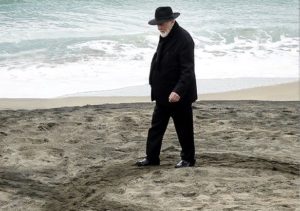
Michelangelo Pistoletto in Ostia on 27th April 2019 on the occasion of the event Sulla sabbia di Ostia (On the sand of Ostia).
Photo by Pierluigi Di Pietro.
What awaits the Earth and its inhabitants? If you look to the future, how do you see our planet in a century?
It may be that in 100 years humanity will have disappeared or will exist in the form of robotics, but we can’t know that. I only know that I am very angry right now, because no one is highlighting the fundamental problem of the excessive multiplication of human beings on the planet. Today, technology gives us the possibility to work until old age without needing to use muscles, so we can leave physical activities to younger people, knowing that aging is no longer such a serious issue. We don’t need to die early to make room for young people. In reality, it would be enough for fewer people to be born to make room for humanity. This is of fundamental importance: we must stop thinking that we white people risk being fewer than black, black fewer than yellow, yellow fewer than blue… we can all be white, black, green, yellow, blue, brown, it doesn’t matter! We can be of a shade that doesn’t exist yet, given by the mixture of various colours. And what does it matter if, by chance, one colour outnumbers the others? It remains that human beings are the ones responsible for their planet, regardless of colour.
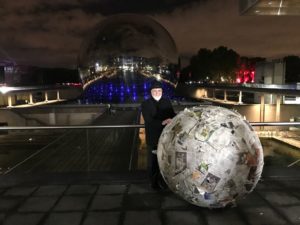
Pistoletto with the Sphere of Newspapers at the Cité des sciences et de l’industrie in Paris during the 2019 Nuit Blanche.
Photo by Saverio Teruzzi.
What is the Earth for Michelangelo Pistoletto? How do you identify the relationship between humans and the planet?
Earth is our survival. As human beings, we are different from any other existing being because we can think. Thought allows us to understand what we are doing, but it has also become very dangerous, because it has led us to create an artificial world now brought to its extreme consequences. We just need to look at financial speculation, which has assumed abnormal proportions: it has transformed the reality of work into a vain chimera. We are already using the profits of hypothetical productive activities of the next generations. At the same time, the system generates profit through wars, by destroying entire countries and then making money on their reconstruction. This is a monstrosity created by mankind. The economy should instead imitate nature, in which everything is born, dies and is continually reborn in a dynamic balance between conservation and renewal. A forest is apparently always the same, but in it everything keeps changing. The human being, on the other hand, cuts down forests and creates deserts. Furthermore, it creates deserts and causes floods by extracting and using fossil materials, which alters the biosphere. For our survival, we must find a balance between human activities and nature. The UN world project on sustainability must guide us. Globally, we are working very well in this direction with the production of solar energy, although some countries are still reluctant to follow this protocol and use clean energy, and continue relying on fossil one.
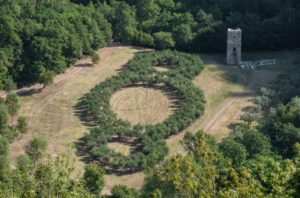
The Third Paradise in St. Francis Wood in Assisi, 2010. Photo courtesy of Lucio Lazzara.
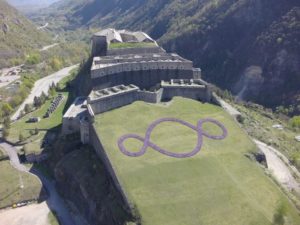
The Third Paradise at the Exilles Fort, 2015. Photo credit: Giorgio Ferraris.
The Coronavirus has led some policymakers to neglect environmental issues and climate change. In this regard, students from all over the world continue making themselves heard on the environmental emergency, and some movements, like Greta Thunberg‘s Fridays for Future, are having global resonance. What advice would you give to the younger generations about how to make this process more effective?
Young people are right to rebel and must understand the gravity of the situation regarding climate change. New generations are right to protest, I too am sorry and angry, but with the help of Cittadellarte’s collaborators, I am also trying to ensure that proposals replace protests1*. Protesting is certainly useful, but if you don’t also pragmatically work on formulating a proposal, it doesn’t lead to change, it only generates a media frenzy ending in itself. It has now become important to work on practical proposals, so that humans can no longer avoid taking full responsibility. There is no responsibility or judgment coming from above anymore: we have reached the hour of judgment and it is we who must judge our work, and then act responsibly to create, here on Earth, the Third Paradise.
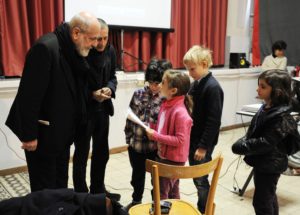
An image of the 2012 Rebirth Day at ISS Manin in Rome. Photo by Danilo Rossi.
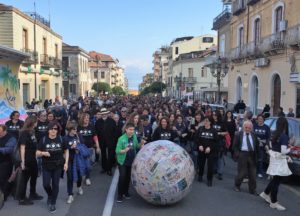
Michelangelo Pistoletto and Maria Pioppi at the 2016 event Arte ed educazione, Terzo Paradiso e scuola per il cambiamento (Art and education, the Third Paradise and the school for change) in Lamezia Terme.
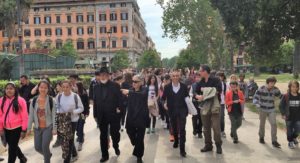
Michelangelo Pistoletto and Maria Pioppi with the students in the gardens of Piazza Vittorio in Rome on the occasion of the 2016 event Il gesto, la parola, la forma: il Terzo Paradiso (The gesture, the word, the form: the Third Paradise) at ISS Manin.
With the trinamic symbol, you reflect and identify a possible synthesis and harmonious relationship between nature and artifice. What path should modern society take to attain the Third Paradise?
The Third Paradise embodies a balanced union between natural paradise and artificial paradise. The first is symbolically represented by a circle, the second by the opposite circle, and together they make two; duality, however, is not static. They come together in the central circle, creating a third element that didn’t exist before. This triple circle is in fact the symbol-formula of creation, and as such it’s not a hypothetical truth, it’s not a fake god, it’s a phenomenology, concerning the existing, scientifically verifiable. It all happens through continuous separation and connection. Our goal must be to finally enter the third stage of humanity, which I have called the Third Paradise.
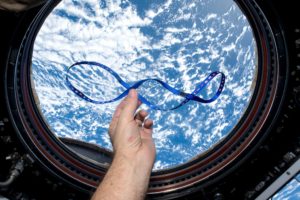
Zero Gravity, Paolo Nespoli – Mission Vita, courtesy of ESA European Space Agency.
The human being, making use of technology, is intensifying the space race by conducting explorations aimed at knowing more about the universe. We know for example about the latest discoveries on the Red Planet, made possible thanks to the Perseverance rover and the Ingenuity drone, used for the Mars 2020 mission developed by NASA, which intends to study the habitability of Mars, investigate its past and look for any traces of biological life. Are these researches relevant to our planet in your opinion?
In one of the latest demonstrations by young people against climate change, I noticed a boy holding a sign in his hand that read “We are going to conquer Mars while we are losing the Earth”. This is something I have vehemently claimed for years. It’s significant that the trinamic symbol of the Third Paradise was adopted by the space mission called VITA2* and taken into orbit for 139 days aboard the ISS – International Space Station by astronaut Paolo Nespoli, together with an international crew. On that occasion, I was asked if I thought there were forms of life similar to us in the universe. I replied that before discovering inhabitants of other planets we should have discovered the inhabitants of the Earth. We need to take on a responsibility that, in addition to eliminating wars on this planet, prevents us from bringing conflicts to a stellar dimension.

Michelangelo Pistoletto. Photo credit: Pierluigi Di Pietro.
In 1994, in your Progetto Arte manifesto, you wrote that the time had come “for artists to take on the responsibility of establishing ties among all other human activities, from economics to politics, science to religion, education to behaviour – in a word, among the threads that make up the fabric of society”. In 2021, after 27 years, has the role of art changed towards our planet?
At Cittadellarte, in the 1990s, we created the University of Ideas. It’s a school that connects all sectors of society, from politics to economics, from religion to education, from behaviour to architecture, from agriculture to urban planning to fashion. This school is still conducting its ongoing research, capitalising on the discoveries made over time. It’s an educational programme addressed to all ages, from kindergarten to the Accademia Unidee, which leads every profession to deal with the world in a truly original way. The role of art is to bring creation to the highest degree of responsibility in every field of human activity.

